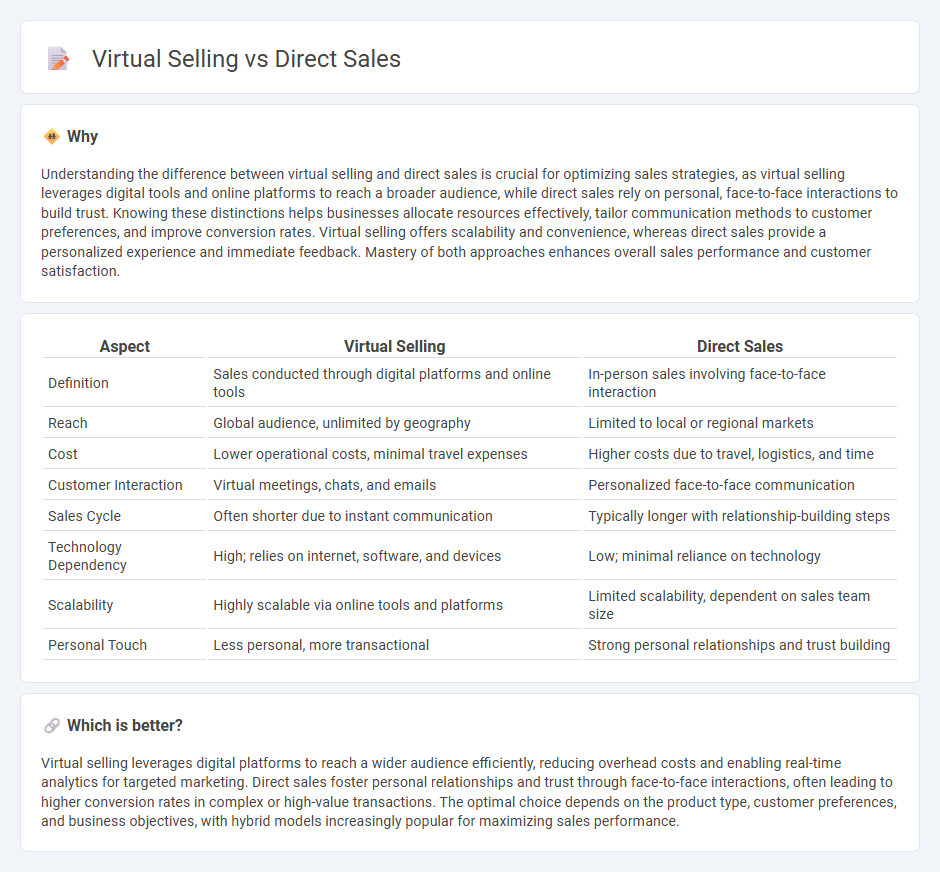
Virtual selling leverages digital platforms to connect with customers, offering convenience and broader reach compared to traditional direct sales, which rely on personal, face-to-face interactions to build trust and close deals. The rise of AI-powered tools and video conferencing has significantly enhanced virtual sales efficiency while maintaining personalization. Discover how integrating these approaches can optimize your sales strategy.
Why it is important
Understanding the difference between virtual selling and direct sales is crucial for optimizing sales strategies, as virtual selling leverages digital tools and online platforms to reach a broader audience, while direct sales rely on personal, face-to-face interactions to build trust. Knowing these distinctions helps businesses allocate resources effectively, tailor communication methods to customer preferences, and improve conversion rates. Virtual selling offers scalability and convenience, whereas direct sales provide a personalized experience and immediate feedback. Mastery of both approaches enhances overall sales performance and customer satisfaction.
Comparison Table
| Aspect | Virtual Selling | Direct Sales |
|---|---|---|
| Definition | Sales conducted through digital platforms and online tools | In-person sales involving face-to-face interaction |
| Reach | Global audience, unlimited by geography | Limited to local or regional markets |
| Cost | Lower operational costs, minimal travel expenses | Higher costs due to travel, logistics, and time |
| Customer Interaction | Virtual meetings, chats, and emails | Personalized face-to-face communication |
| Sales Cycle | Often shorter due to instant communication | Typically longer with relationship-building steps |
| Technology Dependency | High; relies on internet, software, and devices | Low; minimal reliance on technology |
| Scalability | Highly scalable via online tools and platforms | Limited scalability, dependent on sales team size |
| Personal Touch | Less personal, more transactional | Strong personal relationships and trust building |
Which is better?
Virtual selling leverages digital platforms to reach a wider audience efficiently, reducing overhead costs and enabling real-time analytics for targeted marketing. Direct sales foster personal relationships and trust through face-to-face interactions, often leading to higher conversion rates in complex or high-value transactions. The optimal choice depends on the product type, customer preferences, and business objectives, with hybrid models increasingly popular for maximizing sales performance.
Connection
Virtual selling leverages digital platforms and communication tools to engage customers remotely, enhancing the efficiency and reach of direct sales strategies. Direct sales rely on personalized interactions, which virtual selling replicates through video calls, chat, and social media, creating a seamless customer experience. Combining virtual selling with direct sales expands market access and accelerates sales cycles by reducing geographic and time barriers.
Key Terms
Face-to-Face Interaction
Direct sales emphasize in-person communication, allowing sales professionals to leverage body language, eye contact, and immediate feedback to build trust and rapport with customers. Virtual selling relies on digital platforms, which can limit non-verbal cues but offer broader reach and convenience through video calls and online presentations. Explore more about how these approaches impact customer engagement and sales effectiveness.
Digital Communication
Digital communication transforms direct sales by enabling real-time interactions through video calls, social media platforms, and instant messaging apps, enhancing customer engagement and personalized experiences. Virtual selling leverages data analytics and CRM tools to tailor communication strategies, streamline follow-ups, and track customer behavior more efficiently. Explore how integrating advanced digital communication tools can maximize sales performance and customer satisfaction.
Relationship Building
Direct sales emphasizes face-to-face interactions, fostering trust and rapport through personal engagement and non-verbal cues. Virtual selling leverages digital tools such as video calls and CRM platforms to create personalized experiences, enabling scalable relationship management. Explore effective strategies for blending both approaches to maximize customer loyalty and business growth.
Source and External Links
Direct Sales: How Direct Selling Works To Generate Revenue - Direct sales involve selling products directly from the manufacturer or company to consumers without intermediaries, often using personal connections, social media, home parties, or pop-up events for outreach and engagement.
What is Direct Sales? | DealHub - Direct sales bypass traditional retail environments, with independent sales representatives promoting and selling products face-to-face at homes, events, or online, offering personalized experiences and product demonstrations.
Direct selling - Wikipedia - Direct selling is a business model where individuals buy products from a parent organization and sell them directly to customers, either through personal sales (single-level) or by also recruiting others to sell (multi-level marketing).
 dowidth.com
dowidth.com